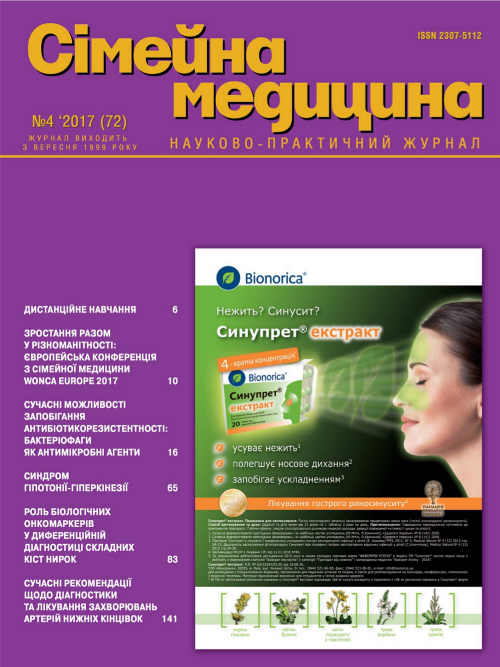Indicators of the system of free radial oxidation in patients with diabetes mellitus after maloinvasive treatment with ureterolytiaase induction
##plugins.themes.bootstrap3.article.main##
Abstract
The objective: to determine the state of free radical oxidation in people with ureterolithiasis and concomitant diabetes mellitus undergoing various methods of minimally invasive surgical treatment of urinary stones.
Patients and methods. The study involved 164 patients and 12 healthy volunteers, of whom men accounted for 93 (56,7%), women – 71 (43,3%) persons. The age range of patients is 19–53 years, on aver age – 34,6±5,5 years. The average age of women is 30,1±2,9 years, and men are 37,6±3,1 years. Patients were divided into IV clinical groups: I – patients with ureterolithiasis and diabetes, which were performed by TUKL (n=34); II – patients with ureterolithiasis and diabetes, which were conducted by the EWHL (n=32); III – patients with ureterolithiasis without diabetes, which was performed by TUKL (n=41); IV – patients with ureterolithiasis without diabetes, which was performed by ESWL (n=57). The control group consisted of healthy volunteers with no signs of pathology (n=12). The studies were performed before and after disintegration of stones by the method of transurethral contact lithotripsy (TUKL) and ESWL.
Results. Conducting an analysis of the indicators of the VR system, the dependence of their displacements on the severity of violations in other parts of the homeostasis and the stage of the DN, provides opportunities for a more complete assessment of the patient’s condition, with the establishment of prospects for treatment under these clinical conditions.
Conclusion. Indicators of metabolic homeostasis reflect the intense processes of the LPO AOP system, which in the case of ureterolithia sis in persons with diabetes mellitus are in most cases uncompensated and are characterized by high risk of development of side effects in the case of the use of the method of ESWL, in contrast to the TUKL technique.
##plugins.themes.bootstrap3.article.details##

This work is licensed under a Creative Commons Attribution 4.0 International License.
Authors retain the copyright and grant the journal the first publication of original scientific articles under the Creative Commons Attribution 4.0 International License, which allows others to distribute work with acknowledgment of authorship and first publication in this journal.
References
Сайдакова Н.О., Старцева Л.М., Кравчук Н.Г. Основні показники уролог. допомоги в Україні за 2010–2011 роки: відомче видання / ДУ «Інститут урології НАМУ», Центр мед. стат. – К.: Поліум, 2011. – 199 с.
Довлатян А.А., Касабов А.В. Острый пиелонефрит при сахарном диабете // Урология. – 2003. – No 6. – С. 20–24.
Cattell W.R. Urinary tract infection and acute renal failure. In: Raine A.E., ed. Advanced renal medicine. Oxford: Oxford University Press, 1992. – P. 302–313.
De Cosmo S., Prudente S., Zamaccia O. et al. PPAR-2D12a polymorphism and albuminuria in patients with type 2 diabetes: a metaanalysis of casecontrol studies. – Nephrol. Dial. Transplant. – 2011. – Vol. 26. – P. 4011–4016
Geerlings S.E., Stolk R.P., Camps M.J. et al. Risk factors for symptomatic urinary tract infection in women with diabetes // Diabetes Care. – 2000. – No 23. – Р. 1737–41.
Дзугкоева Ф.С., Кастуева Н.З., Дзугкоев С.Г. Роль перекисного окисления липидов в патогенезе развития ангиопатий при сахарном диабете. Успехи современного естествознания. – 2005. – No 6. – Р. 95–96.
Зурігат Самер А. Стан ПОЛ у хворих на пієлонефрит при УФО аутокрові // Здоровье мужчины. – 2004. – No 2. – С. 23–25.
Голод Е.А., Даренков А.Ф., Кирпатовский В.И., Яненко Э.К. Перекисное окисление липидов в почечной ткани больных нефролитиазом и хрон. пиелонефритом // Урол. и нефрол. – 1995. – No 5. – С. 8–10.
Голованов С.А., Яненко Э.К., Ходырева Л.А. и др. Диагностическое значение показателей ферментурии, перекисного окисления липидов и экскреции среднемолекулярных токсинов при хрон. пиелонефрите // Урология. – 2001. – No 6. – С. 3–6.
Цветцих В.Е., Крылов В.И., Лернер Г.Н., Бердичевский Б.А. Показатели гомеостаза и функции состояние ферментов антиоксидантной защиты при хроническом пиелонефрите // Урология. – 2000. – No 3. – С. 13–15.
Дзеранов Н.К., Яненко Э.К. Оперативное лечение коралловидного нефролитиаза // Урология. – 2004. – No 1. – С. 34–38.
Streem S.B. Long term incidence and risk factors for recurrent stones following percutaneous nephrostolithotomy or percutaneous nephrostolitotomy: extracorporeal shock wave lithotripsy for infection related calculi // J. Urol. Baltimore. – 1995. – V. 153, N 3 (1). – P. 584–587.
Tashiro K., Iwamuro S., Nacajo H. et al. Stone reccurence after stone free status with extracorporeal shock wave lithotripsy // Nippon Hinyokika and Gakkai Zasshi. – 1997. – V. 88. – P. 434–438.
Фарбирович В.Я., Эйзенах Я.В., Худяшов С.А. Влияние структуры конкрементов на результаты ДЛТ// Урология. – 2001. – No 4. – С. 48–50.
Ошакбаев К.П., Абылайулы Ж., Кожабекова Б.Н. и др. Взаимосвязь эндогенной интоксикации и свободнорадикального окисления при моче-каменной болезни // Урология. – 2007. – No 3. – С. 23–26.





